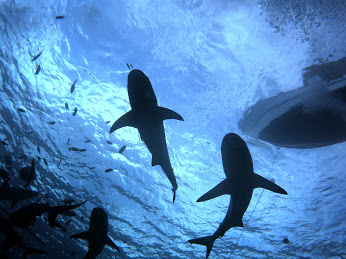
The longest running coastal shark research survey along the East Coast has completed its 2015 field work, capturing and tagging more than 2,800 sharks, the most in the survey’s 29-year history. The results are very good news for shark populations.
“We caught fish throughout the survey,” said Lisa Natanson, a scientist at the Narragansett Laboratory of NOAA Fisheries’ Northeast Fisheries Science Center (NEFSC) and leader of the coastal shark survey. “Sandbar sharks were all along the coast, while most of the dusky sharks were off North Carolina. We captured a bull shark for the first time since 2001, and recaptured 10 sharks previously tagged by our program and two sharks tagged by the Virginia Institute of Marine Science.”
The survey began in 1986 and is conducted every two to three years. It covers coastal waters from Florida, where coastal shark species concentrate during the winter and spring, north to Delaware, where many shark species migrate during spring and summer as more northerly waters warm. Following this migratory route, at this time of year, makes it easier to survey the whole population.
The last survey was in 2012, during which 1,831 sharks were captured and tagged, compared with 2,835 in 2015. Sandbar, Atlantic sharpnose, dusky, and tiger sharks were the most common shark species captured this year. In all, 13 shark species were among the 16 species of fish caught. The three non-shark species were remora, cobia and gold spot eel.
“Sharks are very vulnerable. Even though they are at the top of the oceanic food chain and can live for decades, they are fragile in the sense that compared to other fish they grow very slowly, reproduce late in life and have only a few offspring,” said Karyl Brewster-Geisz of NOAA Fisheries Office of Highly Migratory Species. “An increase in the numbers caught and tagged during each survey indicates a slow climb back. It is very good news for shark populations and for the ecosystem.”
This year, the survey was conducted aboard the 100-foot charter fishing vessel Eagle Eye II from Port Royal, South Carolina, from April 4 to May 22, and from just south of Ft. Pierce, Florida to North Carolina. As in 2012, poor weather and time prevented sampling further north. The surveys are conducted in the 5-40 fathom (30 to 240 feet) depth zone with most sampling between 11-20 fathoms (66 to 120 feet deep) and use commercial Florida-style bottom longline fishing methods to standardize survey results. This method uses a long, or main, line with baited shark hooks spaced at regular intervals along the line.
“The number of fish this year was amazing. We captured and tagged more fish than ever before, but once again weather was a factor. It started off nice, but conditions worsened as we headed north,” said Natanson.
Most (2,179, or 77 percent) of the sharks captured were tagged and released, 434 (15.3 percent) were brought aboard, and 222 (7.8 percent) were released untagged or lost. Researchers record the length, sex, and location of each animal caught. Environmental information, such as water temperature and ocean chemistry, was also obtained at each station.
Researchers do not intentionally kill any animals for their studies. However, some sharks do not survive capture, and these are carefully dissected at sea to obtain biological samples important for studies on shark age and growth, reproduction, and food habits. On this survey, reproductive information was obtained from 170 sharks, backbones were removed for age and growth work from 109 sharks, and stomachs were examined in 82 sharks. The scientists also collect parasites, DNA and blood samples.
Among the catch this year were three white sharks, which were tagged and released; all were less than eight feet long. No white sharks were captured during the 2012 survey, and only one white shark was captured during the 2009 survey. The largest shark captured on the 2015 survey was a tiger shark, 12.5 feet in fork length, off North Carolina.
Natanson said the survey’s primary goal is to gather information about the distribution, abundance, and species composition of sharks found in these waters. Survey objectives also include tagging sharks for migration studies and collecting catch-per-unit-effort data.
“All the survey data are provided to NOAA Fisheries managers to monitor the health and abundance of shark populations in the Atlantic,” said Natanson. "We've seen an increase in the number of sharks in every survey since 2001; that reflects management efforts to conserve the populations of various shark species.”
NOAA Fisheries is the federal agency charged with managing commercial and recreational shark fisheries in U.S. waters, including the Caribbean Sea and the Gulf of Mexico. The United States shark management began in 1993; currently 42 species are managed.
In addition to Natanson and colleagues from the NEFSC's Narragansett and Woods Hole Laboratories, researchers participating in the 2015 survey came from the Southeast Fisheries Science Center, Florida Atlantic University, and the University of New Haven.
Another memorable tale from the 2015 survey says that in addition to the record number of sharks caught this year, which was itself cause for excitement, the team aboard the Eagle Eye II also rescued five people off Oregon Inlet in North Carolina during the survey. Their small fishing boat had experienced engine trouble and was adrift in the Gulf Stream. The boat’s mayday signal was not received by the Coast Guard, but was by the Eagle Eye II, who came to the rescue. After determining that everyone aboard was okay, they contacted the Coast Guard and towed the vessel for a few hours closer to shore, where the Coast Guard took over.